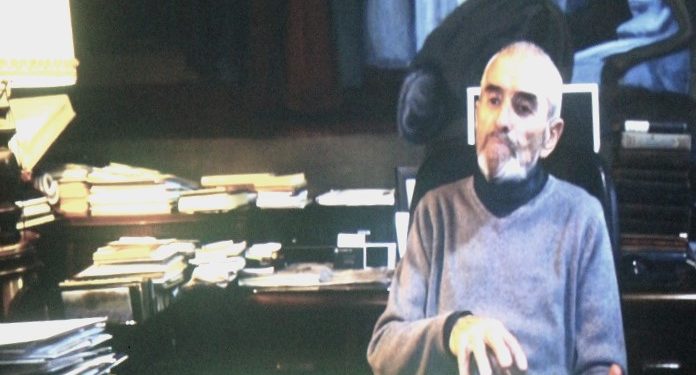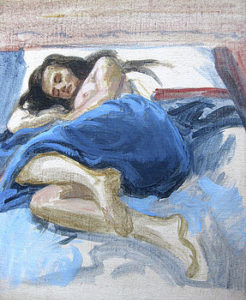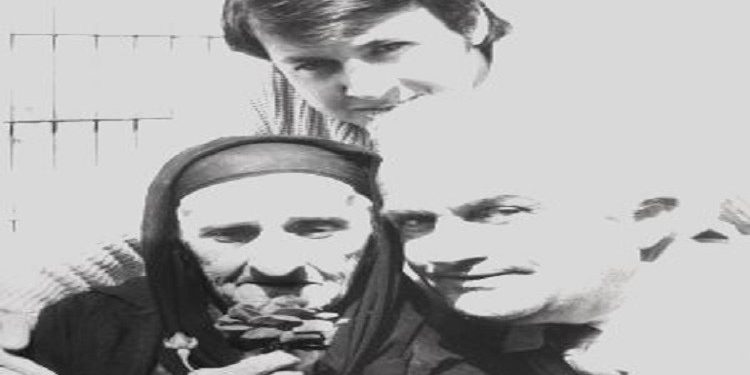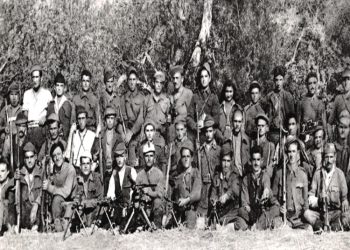By Dalip Greca
Part One
Memorie.al Zoi Shyti (Zois Shuttie), is an artist who has long stood out with his unique creative individuality and has left his mark in America and Europe, he has been welcomed in the capitals of world art; in Paris, London, San Francisco, Mexico, Washington, New York, Philadelphia, and then in Tirana. As an artist and as a man, he carries an interesting story; mysteriously saved from death, helped by fate in the ruins of World War II, when he was still a child; frustrated with hardships in the difficult post-war period, educated at the Artistic Lyceum of Tirana, where, completely against his inclinations and desires, he studied sculpture and not painting; appointed first as a painter in the Tirana Crafts, then as a painter and sculptor in the Border Directorate; he finds the moment and escapes to Greece.
Shyti, let’s talk a little about painting and Zoin, when did they join together on the long journey?
I started drawing and making different shapes of carpets with clay eroded from the Lushnja stream, since the age of six. My childhood friend at that time, the famous poet Faslli Haliti, surprisingly, sent me by email the memories he remembers of me in the time of my innocence, how he, with his pictorial and poetic inclinations, saw me during that difficult time, which for me is a phenomenon of the revival of the nostalgia dormant in the memory of that time. The awareness of my desire to become a painter began when I was pulled alive from the ruins of the bombings in the city of Lushnja.
Bloodied and bandaged from head to toe, with tears in my eyes, I scribbled images of war on the sides of the ruined walls with the charcoal of burnt beams. I never parted with the rags. But the poverty of the post-war period did not give us tools for drawing and painting. I used earth-colored pumice stones, or I squeezed wild colored leaves, which were dangerous and poisonous. In elementary school we drew on the blackboard or on the cement behind the school with chalk, or on the dry ground with a stick scratch. There were no pencils, books were rare, and we didn’t even have pencils. We copied the material one by one and learned it by heart.
My father kept me in the shop to learn the trade, because he wanted me to become a tailor. But my mind was fixed on painting. Out of my anger and against his wishes, I took up carpentry for a year and a half. When I became seriously ill, the doctors removed my thread. And my father gave up his insistence and allowed me to do what I wanted. He himself was in despair, since before returning from America in 1923, he had been a musician with a band in Philadelphia. Misfortune forced him to become a tailor in Lushnja. He, in fact, did not want me to suffer the same fate.
Then you went to the Artistic Lyceum, can we continue the story about your artistic formation and career in Albania?
The seven-year Artistic Lyceum is a separate chapter of the story, but I am not talking about it now. After graduating from the Lyceum in the sculpture department, I was hired by the Border Directorate of the Ministry of the Interior, as a sculptor. After completing a bust, which is still on its pedestal today, I made a large portrait with burnt charcoal, of the Director of the Border Directorate, General Ndreko Rino. It was exhibited at the entrance to the annual exhibition in the ‘Brigade Palace’. The general welcomed it with praise. Then the office entrusted me with the difficult topic of the August 1949 Provocations by the Greeks. It was the main picture of the traveling exhibition of the Border, from Tirana to Durrës and elsewhere. It was 1963.
Half of my family had disappeared, supposedly from disease. The other half was divided. Against the law, I brought my mother, the two orphaned children of my dead sister, and my younger brother and sister to Tirana. We lived cruelly on my salary; six people in one room, with half a toilet. General Ndrekua let me work in a large studio of the Ministry for large-scale paintings. I secretly slept there. But I didn’t have long either. They informed me to do something, because “the climate of Tirana was very bad for me”! As the son of an American, working in the Ministry of the Interior, without party membership, (so I wasn’t a communist) was unacceptable! Then some painters, they were looking down on my place.
Under what circumstances did you escape from Albania and how did you manage to find the “key” to penetrate American artistic circles, where competition is fierce?
Under constant pressure, I was forced to create the possibility of escaping to Greece in 1964. From there, a year later, I came to the United States. I did not know English, but I spoke the language of art. Against the wishes of my relatives in Philadelphia, I attended the ‘Fleisher Memorial Arts’ school after work. Then I enrolled in the ‘Pennsylvania Academy of the Fine Arts’, at Temple University and at the University of Pennsylvania, on a full scholarship, until graduation in 1970, winning several well-deserved awards. I also exhibited in several galleries in the city and in the suburbs and began to become known in artistic circles.
That same year I became an American citizen, and with my first passport in hand and my fiancée, Miss Iowa Carolyn, by my side, we boarded a plane for London and Paris. There I learned about the French school of painting at l’Academie de la Grande Chaumiere with Professor Ives Brayer, and later I learned about Italian Renaissance painting at the Academia dei Belle Arti in Florence. Returning to America, I was invited to teach at the “Instituto Allende in San Miguel de Allende”, in Mexico, where I also received my diploma as a master of painting. Wherever I have lived and wherever I have taught, I have gained some and lost some. Life without losses is as boring as life without gains. But everywhere I have overcome difficulties, without anyone’s help.
What is painting for Zoin?
Painting for me is poetry in color, it is silent music, it is a philosophy that cannot be dictated by anyone other than the one who is in front of it at the moment of execution. Painting is a religious belief of the creativity of beauty by me in my own way, and therefore it is my “religion”.
What has been the greatest pleasure that painting has given you?
My unusual pleasure that I have known from the process of painting is that I have never had the will and desire to separate from it. In front of my painting, I feel like those who are consumed by the coals of love and cannot live without each other. But when the time comes to separate, I have learned to live with the revival of memories on them. Many paintings have been stolen from me. This is because I have traveled and lived in many countries and because I trust people. Unfortunately, I have known very few honest and conscientious people.
And if we think about it, no kind of market price gives the effort of artistic creativity the value it deserves for making that work. I speak for myself. I am rich, not in the sense of possessions, but in the sense of the spiritual and mental fulfillment of my needs, which will one day become the demands of others. I am a “workaholic” and I start work every day early and continue until the next morning.
My itinerary within the walls of my apartment is from the computer to painting, from poetry to literary or informative reading, and in the evening I wander from correspondence to sculpture. When life is full of activities, one does not have time to wander in vain. On the contrary, I often regret that I have not used the time more actively, and I regret that my great desire to wander and to know the world left me unrecognizable to myself and unfinished all those manuscripts on paper.
Have you ever wanted to give up your paintbrush?
The only time I couldn’t hold my paintbrushes in my hands was during chemotherapy and the subsequent period of side effects, which lasted for over five years. At that time, I was shivering from the fever of death, after the needles were inserted into my thigh or stomach. My spine was also shaking, and the worst thing was that there was no heating in my apartment. But from those five years of despair, I did not give up on fate and emerged stronger than others, who watched me from afar, expected.
It was a matter of health, but no, I never wanted to give up my paintbrushes, even for a high-paying job. Even when I taught at institutes, I demonstrated to students how to solve problems in the face of our difficulties, and we would criticize the work together, at the end. With them, the time was filled with joy.
Modesty aside, can you tell me something about the appreciation of Zoi Shyti’s painting, in America and Europe?
The appreciation of my painting has nothing to do with my work, but rather with those who express themselves to satisfy their own opinions. Words are carried away by the wind, our elders used to say, while the works of art that are spoken of remain there, and their value often multiplies with the passing of time. I have met and been in the company of famous people during these forty years in the free world, but what is the importance of those meetings and acquaintances, except for browsing through the book of photographic memories and personal diaries. However, my life, most filled with quenching thirst and with the best impressions, has always been in the company of artists, especially in Parisian circles.
You have had the opportunity to meet many personalities in Europe and the USA, you have corresponded with presidents and personalities, can you say something more concrete about your credentials in this field? Let’s say when you last wrote to President Bush, or when President Clinton last wrote to you?
I have lived among a wide network of friends and acquaintances, collectors and artists known worldwide, as well as high-level people known for their multifaceted contribution to the human good. Each member of that network has reacted differently to my painting, not always favorably: William F. Buckley, American writer and personality of letters, congratulated me in a letter, after the correspondence he had with Princess Grace of Monaco, about me. “I congratulate you” – he wrote to me, – “for your gallant spirit and great talents. With the best impressions that we keep together with my wife, as always, William. Buckley, Jr.”
July 31, 1981.
Alex Daoud, Mayor of Miami Beach, Florida wrote to me: “I have been truly impressed by the wealth of your talent and inspiration that Mother Teresa is a spiritual leader and a source of love and devotion. Your work has been blessed with success…”! Sept 12, 1989.
“I had previously read your poem in ‘DRITA’, and was deeply moved by it,” wrote Gjon Sinishta of the ‘Albanian Catholic Information Center’ in California, in 1986, “The mural painting of Mother Teresa that you have completed is commendable and I would have really liked to have assisted you in that work.”
“In your new life in America, your interest in art will have an ever greater and fuller meaning for you,” wrote the personal secretary of President L.B. Johnson from the White House, on September 18, 1967, when he received the portrait I had painted, commissioned by the International Student House.
President Clinton expressed this in his letter regarding the Kruja landscape with the Myzeqare dance, which I sent him as a quick congratulatory message after his successful heart surgery: “The support of people like you has truly helped me to regain my strength. It is kind of you to think of me, and I am very grateful for your generosity. All the best to you. Sincerely, Bill Clinton (signed).
“From the information we have received, you deserve praise for both your ability and your determination…” wrote Robert Abrahams, secretary of the Wolf Memorial Foundation, 1968.
“I found the poetry beautiful and moving, as were your paintings…! With your paintings, which are truly brilliant, and your poetry, which is equally good, I will always remember the encounter with such a fascinating person…,” wrote the American poet, Jean Meer, in 1970.
“As a wise man said: What we have inherited from our ancestors, we must once again earn ourselves in order to deserve it,” wrote Senator Hugh Scott of Pennsylvania, in September, 1970.
“Sir, in my capacity as laureate of the Silver Medal of the Salon,” the Societe des Artistes Francais invited me to the Grand Palais des Champs-Elysees in 1977, and in 1980, the same invitation came for the Medaille d’Or, which was awarded to me by the Association of French Artists in Paris.
In September 1991, Sokol Necaj, First Secretary of the Mission of the Republic of Albania to the UN, wrote to me: “I will briefly explain to you the status of the work on the opening of your exhibition…! We sent a letter to Mr. Javier Perez de Cuellar, Secretary General of the UN, to help the opening of the exhibition take place at the headquarters of the world organization and that he be the honorary organizer of this event”!
Meanwhile, Mr. Viktor Sharra, Head of the Foreign Department for the Minister of Culture, wrote to me in 1991: “Dear Mr. Zois Shuttie, We are extremely happy that you have the desire and willingness to exhibit your work in Albania, in September…! During your stay in Albania, you will be a friend of the Ministry of Culture, Youth and Sports and we will cover your expenses…”!
The Minister of Culture, Dhimitër Anagnosti, wrote to me in October 1992: “According to the request addressed to the President, Mr. Sali Berisha, we welcome your works, dedicated to the life and tireless work of the Albanian daughter, the well-known humanitarian throughout the world, MOTHER TERESA, to open a traveling exhibition in our country”!
The Minister of Culture, Teodor Laço, wrote in 1995 to the Director of USAID, which no longer exists: “This is a very important exhibition and it is planned to be presented initially in Albania and then, in several countries of Europe. The author’s efforts to bring it to Albania,… have been unsuccessful, due to transportation difficulties,… further efforts have failed for the same reason”!
What other names are there in your correspondence?
I have received recognition from the American Embassy in France, from the Presidency of the French Republic, from the Cabinet of the President of the National Senate of France; from Ministers Jean Tiberi, Pierre Bas and Olivier Guichard; from the Private Secretary of the Queen and Prince Claus of the Netherlands; from the Chamber of Deputies of Brazil; and from Congressman Tom Lantos, not to mention the correspondence with poets and artists of the international arena, friends such as the very famous contemporary artists Eugene Ormandi, Corneille, Salvador Dali, William de Kooning, the Polish-Israeli Ardon, the master Will Barnet and others, very few of whom are still with us. Not to mention, also, the trophies and poetry prizes from the Hollywood Poets Society, and the invitation from the Artistic Director, Vera Pinneira, of the City of Peace Foundation in Brazil, etc…!
Any press recognition?
Journalist Christine Hamm, of the Concord Monitor newspaper, wrote in her article ‘Monument to an Icon’: “Shuttie himself is such a generic image of an artist that he himself could become an icon…! Shuttie differs from many contemporary artists, with his interest in exposing the inhumanity of man to man…! Indeed, Shuttie’s work began as a poem…”!
Shuttie’s “Gallery” is the life of Zoi, how would you define it and what are your plans for the future?
No, I don’t call my studio a gallery. This name suits commercialism today. I call my studio an atelier, which means workshop, workplace. But my walls are covered with paintings. If you had seen the famous operetta Ebraike; “If I were rich, ya-la-la-la-la-la-la-la” I would have bought a big house with many rooms and turned it into a private museum, to leave to the new generations. But, since those dreams after the rain, I will deal with my work, within those conditions.
What place does Albania occupy in your creativity, where you spent 26 years of your sad childhood and youth?
At the beginning of the discovery of my sensitivity regarding the figurative arts, regardless of their artistic level, it is clear that Albania occupies the first place. For me, the seedlings of my artistic fertility sprouted there. I only regret that all my works, mainly Albanian landscapes, disappeared. Especially those of Karavasta and the Pines of Divjaka, and those of the Lakes of Lura.
Do you often take your mind to where you spent your childhood and what place do the memories of that time, the society of that time, occupy in your creativity?
Even though I have lived 45 years outside my homeland, adapting to the cultures and languages of those countries where I have lived, I have never forgotten anything that my memory has preserved in the special places of my being, during this period of four decades. This was the reason that I could not create a family, with any of my admirers, because I wanted my children to speak the language of the Mother, before any other language! Memorie.al
To be continued in the next issue














